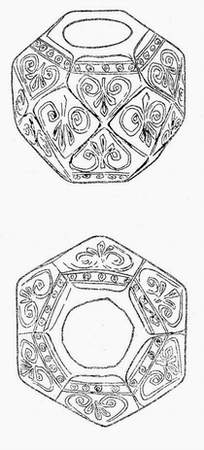this is mace heads from Rus X- XIII century

[ Download ]
[ Download ]
| Piotr Glowacki wrote: |
| Russian arming X-XIII.
a. heavy-armed rider XIV- b. sword from Gniezdowo X. c. Sabre from Goczew 1 half of XI. d. spear from Sachnowka XII/XIII, e. spear from Rajki XII/XIII, f. javelin from Novogrod X, g. battle axe from Gniezdovo X, h. battle axe from kurhan Perejaslawia X/XI. i. mace from Bukryn XII/XIII, j. I dont know how he is kiscien in English but this is something like mace I am apologizing for my English:) |
| Dave Womble wrote: |
| I'm wondering why brass/bronze seems to be a popular material for these maces...when the armour theyre likely to encounter is iron....wouldnt the softer mace head deform? |

| Dave Womble wrote: |
| I'm wondering why brass/bronze seems to be a popular material for these maces...when the armour theyre likely to encounter is iron....wouldnt the softer mace head deform? |
| Dave Womble wrote: |
| A page or so back "flight-maces" were brought up, I believe in an Eastern context...admittedly I didnt read into the posts in detail, I had thought it had been simple flails they were discussing, but apparently there is a seperate weapon completely defined as a flight-mace which has many things in common with a flail.
In that case, Dave, I'm guilty of paying even less attention to previous posts. My apologies. Geoff As to brass/bronze mace heads being used versus lightly or unarmoured combatants, if that were the case, there being numerous combatants with little or no armour, then why wouldn't the sword or lance be used instead? The point of mass weapons in general is to defeat armour. Now I'm not so ignorant to think a heavy piece of metal isn't going to hurt regardless of protection, but a mace certainly wouldnt be the primary choice on the battlefield would it? If it did seem to be the case that you're dealing with lightly armoured enemies. Dave |
| Chad Arnow wrote: |
| There seems to be an opinion among some that brass or bronze is so soft they will basically melt (or shatter) when they strike something hard. :) While they are softer than steel, they are metals that have seen long use in real weapons of war. They wouldn't have been used if they didn't work.As a trombonist, I know a little something about brass. In thin areas, it is pretty dent prone. However, you have to dent it badly for it to split. Items like a mouthpiece are heavier and thicker, but with a maximum thickness of only 0.3 inches or so. In my youth, I hurled a mouthpiece at an old oak door in extreme frustration (I'm not proud of that). The door took a perfect mouthpiece-shaped dent while the mouthpiece itself was undamaged, even in the thinner parts measuring 0.1 inches thick or so. While our ancestors didn't use "flight-mouthpieces" against oak-door clad opponents ( :) ), I think this shows that the right concentration of a cuprous metal can dish out damage to harder surfaces without being compromised.Then you can save your good steel for armour and blades... |
| Merv Cannon wrote: |
|
Yes, I agree Chad.........The original post was about (late) Viking which became Rus / early medieval.......now a lot of these warriors would not have had plate ! |